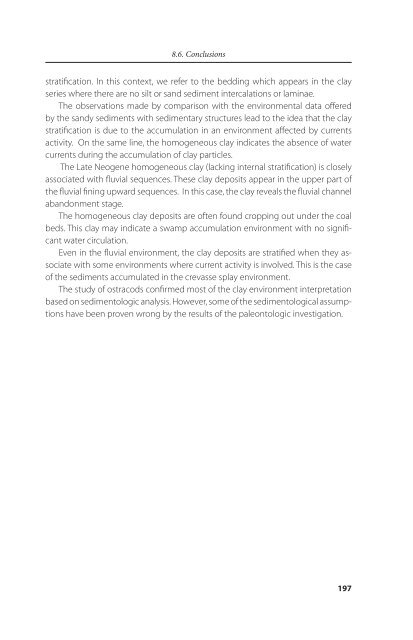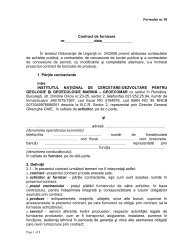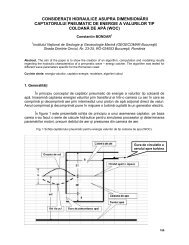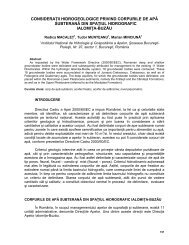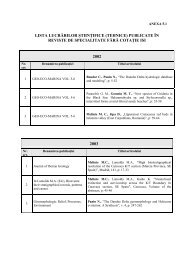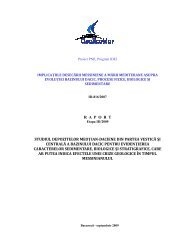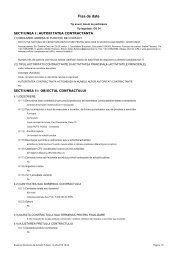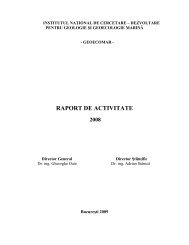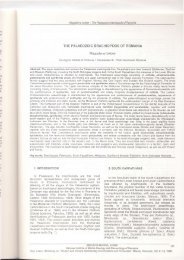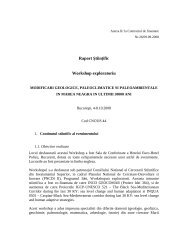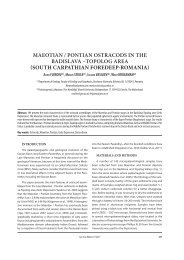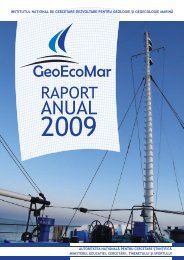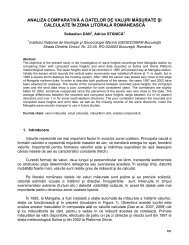- Page 1:
Dan C. Jipa, Cornel Olariu DACIAN B
- Page 5:
Dedicated to the memory of Prof. Gh
- Page 8 and 9:
NATIONAL INSTITUTE OF MARINE GEOLOG
- Page 11 and 12:
CONTENTS Foreword and Acknowledgeme
- Page 13 and 14:
Contents Chapter 7. The Point Bar F
- Page 15 and 16:
FOREwORD AND ACkNOwLEDgEMENTS The s
- Page 17:
PLATE 1. Location of the Dacian Bas
- Page 20 and 21:
18 Chapter 1. Dacian Basin. General
- Page 22 and 23:
20 Chapter 1. Dacian Basin. General
- Page 24 and 25:
22 Chapter 1. Dacian Basin. General
- Page 26 and 27:
24 Chapter 1. Dacian Basin. General
- Page 28 and 29:
26 Chapter 1. Dacian Basin. General
- Page 30 and 31:
28 Chapter 1. Dacian Basin. General
- Page 32 and 33:
30 Chapter 1. Dacian Basin. General
- Page 34 and 35:
32 Chapter 1. Dacian Basin. General
- Page 36 and 37:
34 Chapter 1. Dacian Basin. General
- Page 38 and 39:
36 Chapter 1. Dacian Basin. General
- Page 40 and 41:
38 Chapter 1. Dacian Basin. General
- Page 42 and 43:
The analysis of the paleogeographic
- Page 44 and 45:
42 Chapter 2. Dacian Basin paleogeo
- Page 46 and 47:
44 Chapter 2. Dacian Basin paleogeo
- Page 48 and 49:
46 Chapter 2. Dacian Basin paleogeo
- Page 50 and 51:
48 Chapter 2. Dacian Basin paleogeo
- Page 52 and 53:
50 Chapter 2. Dacian Basin paleogeo
- Page 54 and 55:
52 Chapter 2. Dacian Basin paleogeo
- Page 56 and 57:
54 Chapter 2. Dacian Basin paleogeo
- Page 58 and 59:
56 Chapter 2. Dacian Basin paleogeo
- Page 60 and 61:
58 FIGURE 2.14. Paleogeography and
- Page 62 and 63:
60 Chapter 2. Dacian Basin paleogeo
- Page 64 and 65:
62 Chapter 2. Dacian Basin paleogeo
- Page 66 and 67:
64 Chapter 2. Dacian Basin paleogeo
- Page 68 and 69:
66 Chapter 2. Dacian Basin paleogeo
- Page 70 and 71:
68 Chapter 3. Sediment Thickness Di
- Page 72 and 73:
70 Chapter 3. Sediment Thickness Di
- Page 74 and 75:
72 Chapter 3. Sediment Thickness Di
- Page 76 and 77:
74 Chapter 3. Sediment Thickness Di
- Page 78 and 79:
76 Chapter 3. Sediment Thickness Di
- Page 80 and 81:
78 Chapter 3. Sediment Thickness Di
- Page 82 and 83:
80 Chapter 3. Sediment Thickness Di
- Page 84 and 85:
Sedimentation in the brackish-water
- Page 86 and 87:
84 Chapter 4. Dacian Basin Physiogr
- Page 88 and 89:
86 Chapter 4. Dacian Basin Physiogr
- Page 90 and 91:
88 Chapter 4. Dacian Basin Physiogr
- Page 92 and 93:
90 Chapter 4. Dacian Basin Physiogr
- Page 94 and 95:
92 Chapter 4. Dacian Basin Physiogr
- Page 96 and 97:
94 Chapter 5. Littoral Sedimentary
- Page 98 and 99:
96 Chapter 5. Littoral Sedimentary
- Page 100 and 101:
98 Chapter 5. Littoral Sedimentary
- Page 102 and 103:
100 Chapter 5. Littoral Sedimentary
- Page 104 and 105:
102 Chapter 5. Littoral Sedimentary
- Page 106 and 107:
104 Chapter 5. Littoral Sedimentary
- Page 108 and 109:
106 Chapter 5. Littoral Sedimentary
- Page 110 and 111:
108 Chapter 5. Littoral Sedimentary
- Page 112 and 113:
110 Chapter 5. Littoral Sedimentary
- Page 114 and 115:
112 Chapter 5. Littoral Sedimentary
- Page 116 and 117:
114 Chapter 5. Littoral Sedimentary
- Page 118 and 119:
116 Chapter 5. Littoral Sedimentary
- Page 120 and 121:
118 Chapter 5. Littoral Sedimentary
- Page 122 and 123:
120 Chapter 5. Littoral Sedimentary
- Page 124 and 125:
122 Chapter 5. Littoral Sedimentary
- Page 126 and 127:
124 Chapter 5. Littoral Sedimentary
- Page 128 and 129:
126 Chapter 5. Littoral Sedimentary
- Page 130 and 131:
128 Chapter 5. Littoral Sedimentary
- Page 132 and 133:
130 Chapter 5. Littoral Sedimentary
- Page 134 and 135:
132 Chapter 5. Littoral Sedimentary
- Page 136 and 137:
Fluvial sedimentation played a majo
- Page 138 and 139:
136 Chapter 6. Upper Neogene Fluvia
- Page 140 and 141:
138 Chapter 6. Upper Neogene Fluvia
- Page 142 and 143:
140 Chapter 6. Upper Neogene Fluvia
- Page 144 and 145:
142 Chapter 6. Upper Neogene Fluvia
- Page 146 and 147:
144 Chapter 6. Upper Neogene Fluvia
- Page 148 and 149: 146 Chapter 6. Upper Neogene Fluvia
- Page 150 and 151: 148 Chapter 6. Upper Neogene Fluvia
- Page 152 and 153: 150 Chapter 6. Upper Neogene Fluvia
- Page 154 and 155: 152 Chapter 6. Upper Neogene Fluvia
- Page 156 and 157: 154 Chapter 6. Upper Neogene Fluvia
- Page 158 and 159: The large and continuous rock expos
- Page 160 and 161: 158 Chapter 7. The Point Bar Facies
- Page 162 and 163: 160 Chapter 7. The Point Bar Facies
- Page 164 and 165: 162 Chapter 7. The Point Bar Facies
- Page 166 and 167: 164 Chapter 7. The Point Bar Facies
- Page 168 and 169: 166 Chapter 7. The Point Bar Facies
- Page 170 and 171: 168 Chapter 7. The Point Bar Facies
- Page 172 and 173: 170 Chapter 7. The Point Bar Facies
- Page 174 and 175: 172 Chapter 7. The Point Bar Facies
- Page 176 and 177: 174 Chapter 7. The Point Bar Facies
- Page 178 and 179: 176 Chapter 7. The Point Bar Facies
- Page 180 and 181: 178 Chapter 7. The Point Bar Facies
- Page 182 and 183: 180 Chapter 7. The Point Bar Facies
- Page 184 and 185: 182 Chapter 7. The Point Bar Facies
- Page 186 and 187: 184 Chapter 7. The Point Bar Facies
- Page 188 and 189: 186 Chapter 7. The Point Bar Facies
- Page 190 and 191: 188 Chapter 7. The Point Bar Facies
- Page 192 and 193: 190 Chapter 8. The Paleoenvironment
- Page 194 and 195: 192 Chapter 8. The Paleoenvironment
- Page 196 and 197: 194 Chapter 8. The Paleoenvironment
- Page 200 and 201: The evolution and architecture of a
- Page 202 and 203: 200 Chapter 9. Source-Areas in the
- Page 204 and 205: 202 Chapter 9. Source-Areas in the
- Page 206 and 207: 204 Chapter 9. Source-Areas in the
- Page 208 and 209: 206 Chapter 9. Source-Areas in the
- Page 210 and 211: 208 Chapter 9. Source-Areas in the
- Page 212 and 213: 210 Chapter 9. Source-Areas in the
- Page 214 and 215: 10.1. SEDIMENT ACCUMULATION AREAS I
- Page 216 and 217: 214 Chapter 10. History of the Daci
- Page 218 and 219: 216 Chapter 10. History of the Daci
- Page 220 and 221: 218 Chapter 10. History of the Daci
- Page 222 and 223: 220 Chapter 10. History of the Daci
- Page 224 and 225: 222 Chapter 10. History of the Daci
- Page 226 and 227: 224 Chapter 10. History of the Daci
- Page 228 and 229: 226 Chapter 10. History of the Daci
- Page 230 and 231: 228 Chapter 10. History of the Daci
- Page 232 and 233: 230 Chapter 11. From Brackish-Marin
- Page 234 and 235: 232 Chapter 11. From Brackish-Marin
- Page 236 and 237: 234 Chapter 11. From Brackish-Marin
- Page 238 and 239: 236 Chapter 11. From Brackish-Marin
- Page 240 and 241: 238 Chapter 11. From Brackish-Marin
- Page 242 and 243: 240 Chapter 11. From Brackish-Marin
- Page 244 and 245: 242 Chapter 11. From Brackish-Marin
- Page 246 and 247: 244 Chapter 11. From Brackish-Marin
- Page 248 and 249:
246 Chapter 12. From Brackish-Marin
- Page 250 and 251:
248 Chapter 12. From Brackish-Marin
- Page 252 and 253:
250 Chapter 12. From Brackish-Marin
- Page 254 and 255:
252 Chapter 12. From Brackish-Marin
- Page 256 and 257:
254 Chapter 12. From Brackish-Marin
- Page 258 and 259:
Ai n s w o r t h r. B., Cr o w l e
- Page 260 and 261:
258 References hA m o r, g., et al.
- Page 262 and 263:
260 References mA C A r o V iC i, n
- Page 264 and 265:
262 References ră d A n, s.C., 200
- Page 266:
264 References VAsilieV, i., Kr iJ


